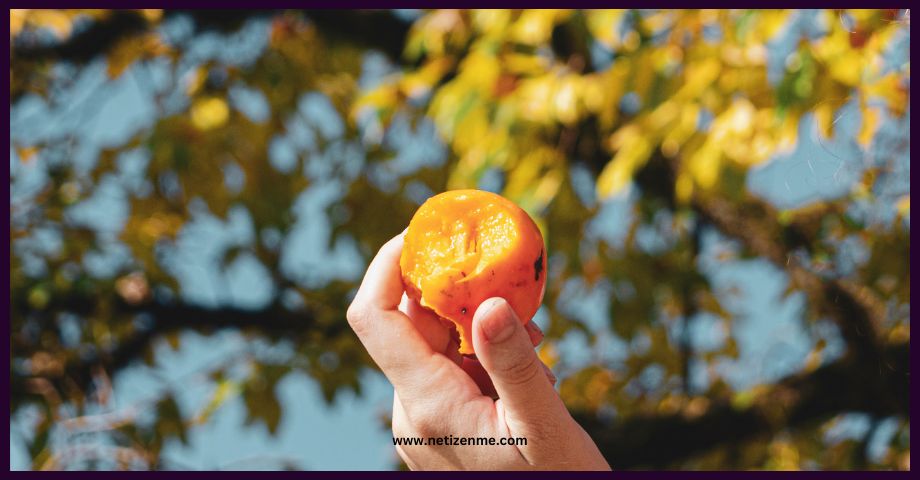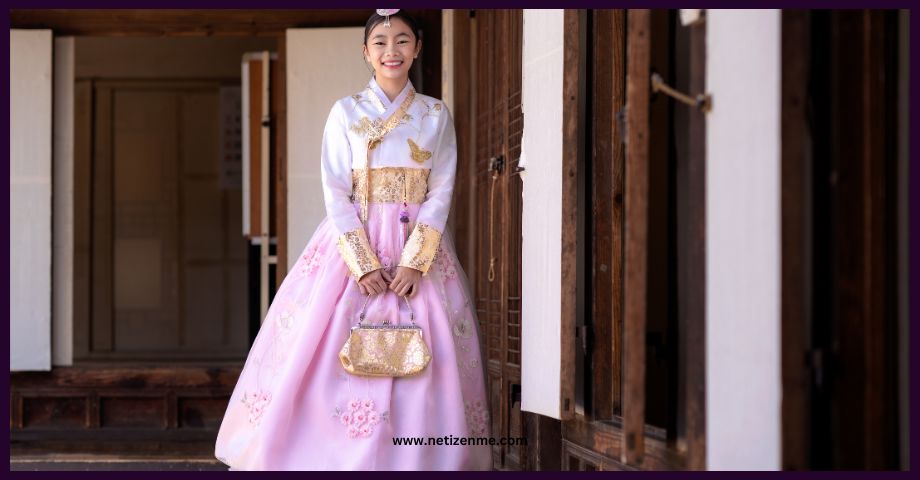The persimmon, a vibrant and beloved fruit, is central to Korean culture and traditions. Let’s explore the rich history and significance of the persimmon in Korea, shedding light on the fruit’s cultural, culinary, and symbolic importance.
Varieties of Korean Persimmons
Korea boasts two distinct types of persimmons, each with unique characteristics and culinary uses. Deeply intertwined with Korean culture, these fruits come in two varieties: the Hachiya Persimmon and the Fuyu Persimmon.
- Hachiya Persimmon (떫은감) – “The Sour Persimmon”The Hachiya Persimmon, known as “tteolbeun gam” in Korean, earned its moniker, “The Sour Persimmon” for its initial tartness. This variety features deep orange flesh, an acorn-like shape, and a soft texture, which might even make one mistake it for a tomato at first glance. However, its sweetness emerges as it ripens, accompanied by abundant pulpiness. Eating a ripe Hachiya can be a delightful, albeit slightly messy, experience.
- Fuyu Persimmon (단감) – “The Sweet Persimmon”The Fuyu Persimmon, or “dan gam” in Korean, is aptly named “The Sweet Persimmon” for its naturally sweet and enjoyable flavor. With its light-colored orange flesh, round shape, and flat bottom, the Fuyu persimmon offers a unique and delightful experience. Notably, these persimmons can be consumed when nearly ripe, with or without their skin. The Fuyu variety, often favored by many, can be enjoyed like an apple, further enhancing its appeal.
Even for those who may not have a particular fondness for persimmons, the vibrant and rich colors of these fruits undoubtedly add a vivid and captivating element to Korea’s scenic beauty. Persimmon trees, known as “gam namu,” are a common sight throughout the country, especially in its mountainous regions, where they contribute to the landscape’s charm and have historical significance, being used for crafting traditional Korean furniture.
The diversity of persimmon varieties in Korea reflects the nation’s culinary ingenuity and ability to transform these fruits into sweet and savory delights, making them a cherished part of Korean culture.
Culinary Delights: Persimmon as a Versatile Ingredient
Korean cuisine showcases the persimmon’s versatility, with ripe and unripe fruits used in various dishes. Persimmons are celebrated for their sweet and tangy flavor, making them a popular ingredient in many Korean recipes.
- Delectable Persimmon Dishes: Ripe persimmons are often enjoyed fresh or incorporated into dishes like salads and desserts. Dried persimmons (gotgam) are a popular snack, and they are also used in traditional recipes like “Shiikhye,” a sweet rice beverage, and traditional Korean cinnamon punch, known as “sujeonggwa.” Persimmons can also be used to make kimchi called “gamnip kimchi.” This kimchi is slightly sweet and pairs well with traditional Korean dishes.
- Persimmon for Preservation: Unripe persimmons are widely used in Korean cuisine for making “gotgamssam,” a type of dried persimmon snack, and for pickling to create “gotgam jangajji.”
- Significance in Celebrations: Persimmon-based dishes are commonly prepared during holidays and special occasions, symbolizing good fortune and sweet moments.
Cultural Symbolism: Persimmon in Korean Traditions
The persimmon transcends its culinary role and finds a prominent place in Korean traditions and customs.
- Lunar New Year: Persimmons are a traditional and symbolic gift exchanged during the Korean Lunar New Year (Seollal). They represent good fortune and wealth for the upcoming year.
- Harvest Festivals: Persimmons are a prominent feature of Chuseok, the Korean autumn harvest festival. They are often displayed in homes and used in ancestral rites to honor and remember deceased family members.
- Weddings: In traditional Korean weddings, persimmons are sometimes included in the bride’s gift chest. This gesture signifies a wish for a prosperous and harmonious marriage.
The Persimmon Tree: A Cultural Icon
The persimmon tree itself holds a special place in Korean culture. It is often found in traditional Korean gardens and is revered for its resilience and beauty.
Korean Art and Literature: The persimmon tree has been a recurring motif in Korean art, literature, and poetry, representing endurance and continuity.
Natural Symbolism: Its enduring green leaves in winter symbolize hope and renewal, contributing to its popularity in traditional gardens.
The Symbolic Significance of Persimmons
The persimmon, known as “gam” in Korean, carries profound symbolism in Korean culture and is often associated with transformation and change. Before ripening, the persimmon is green and exceedingly bitter. However, as it ripens, it transforms remarkably into a vibrant orange fruit with a luscious sweetness. This transition from bitterness to sweetness has made the persimmon a potent symbol of transformation.
Most persimmons are enjoyed when fully ripe, showcasing the sweet culmination of their journey. This “bitter to sweet” symbolism is not lost on those who savor these delightful fruits.
- Fertility and Prosperity: In Korean culture, persimmons are often associated with fertility, abundance, and prosperity. The vibrant orange color of ripe persimmons symbolizes the harvest and abundance of life.
- Longevity: Persimmons are considered a fruit of longevity, and they are sometimes included in celebrations for older family members to wish them a long and healthy life.
Korean Persimmons and Buddhism
Korean persimmons have a unique and intriguing connection to Buddhism, which has played a significant role in shaping the culture and traditions of South Korea. Here’s an exploration of how persimmons are intertwined with Buddhism in Korean society:
1. Temple Groves: Many Buddhist temples in South Korea maintain orchards and groves of persimmon trees within their premises. These temple groves serve both practical and symbolic purposes. Monks often care for these trees, and the persimmons harvested are used to support the temple community. This cultivation practice reflects the self-sufficiency and sustainability valued in Buddhism.
2. Symbolism: In Buddhism, the persimmon is seen as a symbol of enlightenment. The fruit transforms its astringent, bitter state to a sweet and ripe one, symbolizing the journey of spiritual growth and awakening. This transformation mirrors the Buddhist concept of enlightenment, where individuals evolve from ignorance to wisdom.
3. Meditation and Mindfulness: Buddhist monks and practitioners engage in mindful practices, and eating a persimmon can be a meditative experience. The careful consideration of each bite, the taste, and the appreciation of the fruit’s natural qualities align with the principles of mindfulness taught in Buddhism.
4. Rituals and Offerings: Persimmons are often offered as part of rituals and ceremonies in Buddhist temples. They are symbolic offerings during Buddhist services and rituals, signifying the offering of one’s best to honor and connect with the spiritual realm.
5. Seasonal Celebrations: Persimmons are frequently featured in Buddhist celebrations and rituals related to seasonal changes, particularly during autumn. As persimmons ripen in the fall, they are used in offerings and feasts to mark the changing seasons and express gratitude for the harvest.
6. Connection to the Earth: Buddhism strongly emphasizes interconnectedness with nature and the Earth. Persimmon cultivation and consumption represent a harmonious relationship with the environment. Monastic communities often follow environmentally friendly practices and sustainably use natural resources.
Korean persimmons have a profound presence in the context of Buddhism in South Korea. They serve as a symbol of enlightenment and transformation, and their cultivation and use in temple communities align with the values of sustainability, mindfulness, and interconnectedness central to Buddhist teachings. Persimmons offer a tangible and meaningful link between the spiritual and the natural world, enriching Korea’s cultural and religious tapestry.
The Historical Roots of Persimmon in Korea
The persimmon, scientifically known as Diospyros kaki, has been cultivated in Korea for over a millennium. Its history dates back to the Three Kingdoms period, around the 4th century AD. Persimmon trees thrived in Korea’s favorable climate, becoming a staple in Korean agriculture and daily life.
Persimmons in Jongga Ancestral Rituals
The significance of persimmons extends to Korean ancestral rituals, particularly the “Jongga Ancestral Rituals.” In these rituals, persimmon fruit holds a place of great importance. According to the sacred scriptures, the persimmon’s role in these rituals is rooted in a unique aspect of its cultivation.
When the seed of a persimmon is planted, the resulting tree will yield small-sized, astringent fruit. To counter this, a branch from this tree is taken after three to five years and grafted onto another persimmon tree. This grafting process is crucial to produce high-quality fruit. With its complex cultivation, the persimmon tree serves as a metaphor in these rituals, symbolizing individuals’ need to undergo education and personal growth to become valuable members of society.
Essentially, the persimmon’s journey from bitterness to sweetness embodies its transformation and the broader concept of personal growth and societal education. It reminds us that, like the persimmon, individuals too can undergo a profound transformation and contribute to the world’s richness.
The Enduring Significance of the Persimmon
The persimmon’s deep-rooted significance in Korean culture and tradition reflects a harmonious blend of history, culinary artistry, symbolism, and the resilience of nature. As Korea embraces the present while honoring its past, the persimmon remains a cherished and enduring symbol of cultural richness.
Challenges and Modern Adaptations
As Korea continues to evolve, so does the role of the persimmon in contemporary society.
Changing Agriculture: Modern agriculture practices and urbanization have impacted the traditional cultivation of persimmons. Global markets often favor standardized fruit varieties that meet specific size, shape, and quality requirements. Traditional persimmon varieties, which may have unique flavors and characteristics, are sometimes replaced by commercially preferred types. This shift towards standardization can limit the diversity of persimmon cultivars grown.
Persimmon Innovations: Chefs and food enthusiasts experiment with persimmons, creating new and innovative dishes and showcasing the fruit’s adaptability. Modern agriculture has seen the adoption of more intensive farming methods, driven by the need to meet increasing global demand for food. These practices often involve monoculture, where large expanses of land are dedicated to a single crop, and chemical fertilizers and pesticides are used. Traditional persimmon orchards may employ more diversified and sustainable farming methods and have been transformed into high-yield monoculture farms.
The Arrival of Korean Persimmon Harvest Season
As autumn descends upon Korea, the landscape transforms with the promise of a bountiful persimmon harvest. One such place where this seasonal spectacle unfolds is Agyang Village, renowned for its Daebong persimmons, whose roots trace back to the early Joseon period. In ancient times, the Daebong persimmons were esteemed for their exceptional quality and were reserved exclusively for the King.
The unique character of the Daebong persimmons owes much to the favorable natural conditions that envelop Agyang Village. Here, the persimmon trees are nurtured by the pure waters of the Seomjingang River, the crisp mountain air from Jirisan Mountain, and the fertile Hadong soil. This combination bestows the persimmons a flavor that truly distinguishes them from the rest. Dried persimmons from this region hold a special allure, boasting minimal loss of vitamins and an extra sweetness.
The dried persimmons of Hadong are celebrated for their impressive size and unparalleled sweetness, a testament to the region’s dedication to preserving traditional practices. It is often said that once you savor the sweetness of Hadong’s dried persimmons, the taste remains etched in your memory forever.
Every year, as November unfolds, Agyang Village comes alive with a festival that pays homage to the Daebong Persimmons. This joyous occasion is a time for both locals and visitors to revel in the vibrant colors and flavors of the harvest season, celebrating the rich heritage and cultural significance of these remarkable fruits.
In the heart of this quaint village, the persimmon harvest is not merely a season; it is a cherished tradition, a testament to the enduring connection between nature, culture, and the sweet rewards of the earth.
This article is written by:

Eunjin Kim
With a background in art and design, driven by her passion for artistic expression and cultural promotion, Eunjin is on a mission to shine a spotlight on the vibrant heritage and irresistible charm that South Korea has to offer.




